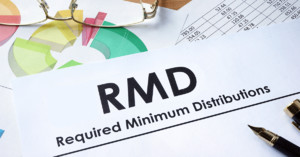Posted on Dec 28, 2021
A required minimum distribution, or RMD, is the minimum amount that must be withdrawn each year from a retirement account such as an IRA, 401(K), 403(B) or other retirement plan. Before the SECURE Act took effect in December 2019, age 70 ½ was the RMD age. Now, it is age 72 for individuals who turned 70 ½ in calendar year 2020. These individuals must take their first RMD by April 1 of the year after they reach age 72, and on December 31 in following years. It’s important to note that the 2020 suspension of RMDs is only for one year unless Congress waives or delays the RMD again.
How do you calculate your RMD? The IRS provides worksheets and life expectancy tables to determine RMDs. For owners of IRA accounts, the RMD must be calculated separately for each IRA that is owned, but the individual can withdraw the total amount from one or more of their IRAs. This is also true for owners of 403(b) accounts, but RMDs required from other types of retirement plans, such as 401(k) and 457(b) plans, have to be taken separately from each of those plan accounts. Roth IRAs, however, do not require withdrawals until after the death of the account owner.
Distributions from a traditional IRA are taxed as ordinary income, but for nondeductible contributions, not all of the distribution is taxable. It’s critical to take RMDs in accordance with IRS rules, because penalties are steep otherwise. The penalty for not taking an RMD or for taking less than the required amount is 50 percent of the amount not taken on time. Since RMDs are counted as ordinary income, many people opt to have taxes withheld from their RMD rather than set aside money to pay taxes later.
For defined contribution plan participants or IRA owners who die after December 31, 2019, the SECURE Act requires that the entire balance of the participant’s account must be distributed within ten years. The IRS does make an exception for a surviving spouse, a child who has not reached the age of majority, a disabled or chronically ill person, or a person not more than ten years younger than the employee or IRA account owner. The new 10-year rule applies regardless of whether the participant dies before, on, or after, the required beginning date, now age 72.
What about those who turned age 70 ½ in 2019 and already started taking their RMDs? It’s best to consult with a tax professional regarding future distributions.
This material is provided for informational purposes only, and is not intended as authoritative guidance, legal advice, or assurance of compliance with state and federal regulations.
Back to Blogs Helpful Resource Links
